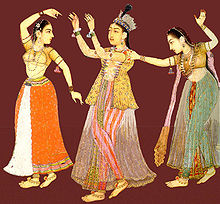Tutinama
Fables | |
Publication date | 14th century |
|---|---|
Tutinama (
The adventure stories narrated by a parrot, night after night, for 52 successive nights, are moralistic stories to persuade his female owner Khojasta not to commit any adulterous act with any lover, in the absence of her husband. She is always on the point of leaving the house to meet her lover, until the loyal parrot detains her by a fascinating story.
Several illustrated manuscript copies survive, the most famous made for the Mughal Emperor Akbar over the five years after he ascended the throne in 1556,
Text
The authorship of the text of the Tutinama is credited to Ziya'al-Din Nakhshabi or just
Akbar's first version
The two artists
Most of the paintings are now in the
In one miniature the figure of the king in the story is the earliest known portrait of Akbar.[15]
Theme of the story

The main narrator of the 52 stories of Tutinama is a parrot, who tells stories to his owner, a woman called Khojasta, in order to prevent her from committing any illicit affair while her husband (a merchant by the name Maimunis) is away on business. The merchant had gone on his business trip leaving behind his wife in the company of a
- One story
A particular tale narrated by the parrot to rivet the attention of his mistress, as she is about to leave the house in the night, is also depicted in the 35th to 37th paintings in the illustrated version of the Tutinama. The story related by the parrot is of a Brahmin boy falling in love with a princess, considered a fated (doomed) situation. But a solution to this is provided by a magician friend of the Brahmin in the form of magic beads to help his friend to turn into a beautiful woman to seek entry into the palace to be with his loved one. The magician further facilitates the meeting of his friend with the king's daughter by telling the King that the girl in question was his daughter-in-law. On seeking entry into the palace the Brahmin discloses his true identity to his adored princess. But a twist is introduced into the tale with the King's son beholding a beautiful girl (the Brahmin in disguise) while taking bath in a pond falls in love with her. To avoid discovery of his true identity, the Brahmin runs away with the King's daughter. The magician then appears before the King seeking return of his daughter-in-law. But the King realising the true state of the two missing girls, compensates the magician with rich gifts. The gifts are passed on by the magician to his Brahmin friend and his wife to enable them to lead a happy life. The parrot concludes the narration, towards day break, with the advice to Kojasta that she should also have everything in life including her husband.[18]
Style of paintings

It is said that the text of the Tutinama was written in Nasta'liq calligraphy style. But each of the paintings seen in various libraries across the world focus on a single topic or episode of the stories. The straightforwardness of expressions seen in the paintings is attributed to the influence of pre-Mughal paintings. Several portfolios of Tutinama are also stated to be similar to the Malwa manuscripts with illustrations (dated to 1439 AD) but with distinct perfection. The difference is traced to the tasteful colours in Tutinama paintings, which make it rich in colours with graded quality.[10][19][20]
The popular dance form of Kathak, considered a combination of Indian and Persian forms, got a medium for display in the paintings of the Tutinama, the Akbarnama and the Tarrikh-e-Khandan-e-Timuria. In these paintings, men and women are shown wearing long flowing robes and high conical caps in standing positions. Even some paintings depicted two different groups of dancers. It is stated that 350 dancers, who were brought to Akbar's court from Iran by force, probably represented the ancient traditions of dances of Iran. It is inferred that over the years, assimilation of the Persian and the Indian people took place and provided the backdrop for the present Kathak dance style in India.[21]
See also
- Sindbad-Nameh
Notes
- ^ Beach (1992), 21–38
- ^ a b "Institute for Oriental Study, Thane: Seminar on "Suhbashita, Panchatantra & Gnomic Literature in Ancient & Medieval India"". Effect of this Migration on Art. Archived from the original on 2012-08-20. Retrieved 2009-09-25.
- ^ Wilson, Horace Hayman (1836). Notes on the Indica of Ctesias. Ashmolean society. pp. 52–53. Retrieved 2009-09-23.
{{cite book}}:|work=ignored (help) - ^ A N D Haksar. "Shuka Saptati – Seventy Tales of the Parrot". Archived from the original on 2012-02-23. Retrieved 2009-09-23.
- ^ a b c "The Parrot". Retrieved 2009-09-21.
- ^ Beach (1992), 34
- ^ )
- ^ a b Beach (1992), 28-29
- ^ Losty, 32
- ^ a b c "Nasta'liq calligraphy as patronized by Akbar, c.1580". Retrieved 2009-09-25.
- ^ see for next para
- ^ "History of Mughal Painting". Retrieved 2009-09-25.
- )
- ^ "Miniatures". Miniature Club. Archived from the original on 2008-08-28. Retrieved 2009-09-24.
- ^ Beach (1987), 56
- ^ "Collections".
- ^ Beach (1992), 21
- ^ Beach (1987), 53
- )
- )
- ^ "The Colosseum". Retrieved 2009-09-25.
References
- Beach, Milo Cleveland (1992), Mughal and Rajput painting, Part 1, Volume 3, Cambridge University Press, 1992 (pp. 21–38), google books
- ISBN 9780674221857, google books
- Losty, J. P. Roy, Malini (eds), Mughal India: Art, Culture and Empire, 2013, British Library, ISBN 0712358706, 9780712358705
- Stephen, A. Condie, and Z̤iyāʼ al-Dīn Nakhshabī. Fairy Tales of a Parrot. London: E. Nister, 1892.
